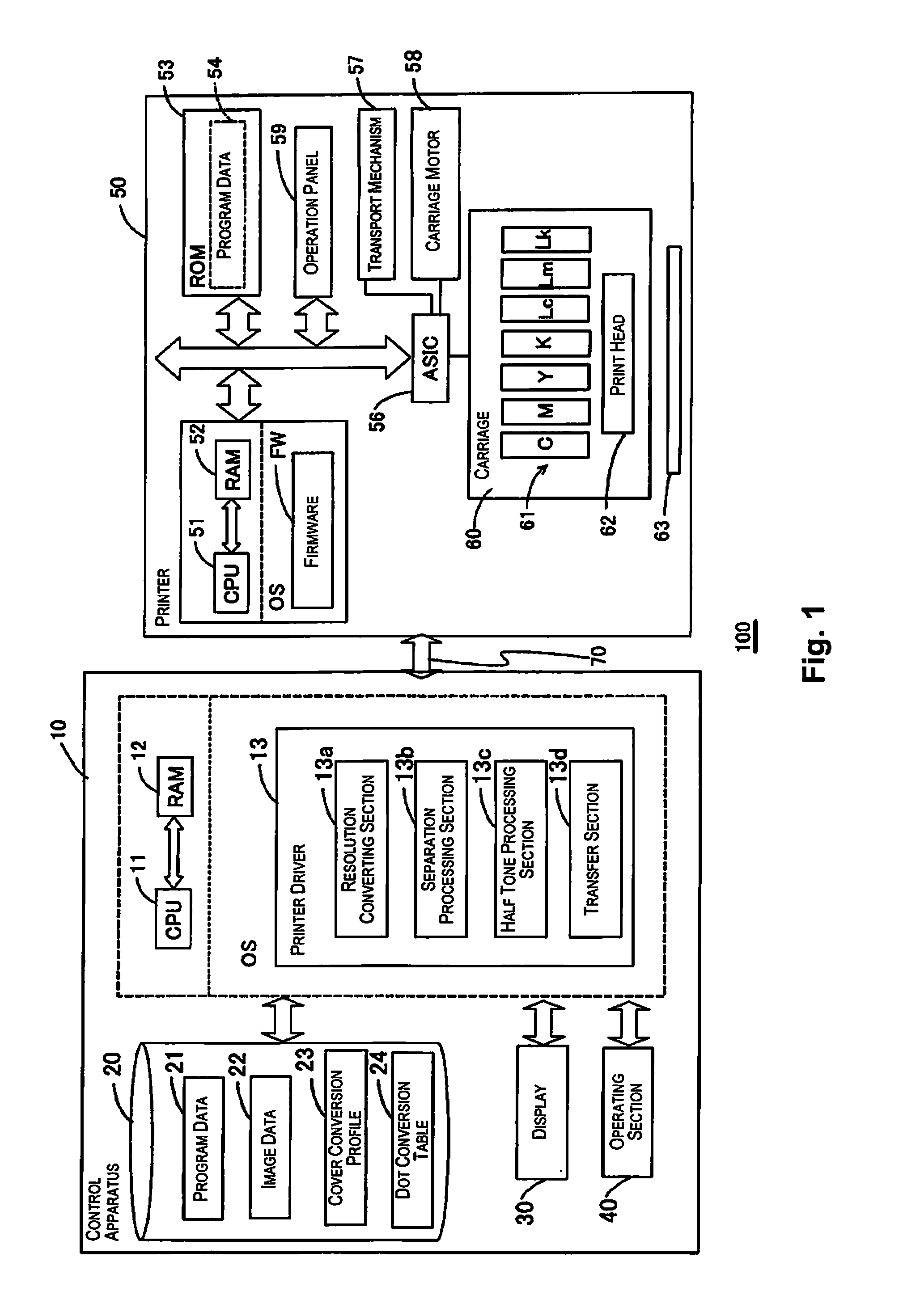Printing apparatus and printing method
a printing apparatus and printing method technology, applied in the field of printing apparatus and printing method, can solve the problems of density unevenness, density unevenness is generated, cockling unevenness, etc., and achieve the effect of suppressing density unevenness and suppressing dots bleeding
- Summary
- Abstract
- Description
- Claims
- Application Information
AI Technical Summary
Benefits of technology
Problems solved by technology
Method used
Image
Examples
first embodiment
1. First Embodiment
1.1. Configuration of Print Control Apparatus
[0038]FIG. 1 schematically illustrates a hardware configuration and a software configuration according to the illustrated embodiment. FIG. 1 illustrates a control apparatus 10 and a printer 50. The control apparatus 10 has a function of executing printing in the printer 50 by controlling the printer 50 and corresponds to, for example, a personal computer (a PC), a server, a mobile terminal apparatus, or the like. The printer 50 is an output apparatus (JIS X0012-1990) which creates a hard copy recording of data with rows of discrete graphic characters, which belong to one or a plurality of character collections which are determined in advance, as the main format. In many cases, it is also possible to use the printer as a plotter. A plotter is an output apparatus (JIS X0012-1990) which directly produces a hard copy recording of data in the format of two-dimensional graphics on a medium which is able to be removed. It is s...
second embodiment
2. Second Embodiment
[0092]In a second embodiment, an ink with a high brightness compared to the first ink is used as the second ink, but the second embodiment is different to the first embodiment in the configuration where the first ink and the second ink are not the same color. As a result, in the second embodiment, in a case where the first ink is any of cyan, magenta, and black, the second ink is any of light cyan (Lc), light magenta (Lm), gray (Lk), and yellow (Y). It is obvious that the relationship characteristics between the first ink and the second ink are not limited to this as long as there is a difference in brightness.
[0093]FIGS. 11A and 11B are diagrams explaining a separation process according to the second embodiment. In FIG. 11A, the first ink is cyan (C) and the second ink is yellow (Y). That is, the second embodiment is the same as the first embodiment in the configuration where the dots of the first ink and the dots of the second ink are formed at positions which ...
modified example 1
[0102]The countermeasure for cockling unevenness in the present application may be applied only with regard to print substrate where it is easy for cockling to occur. For example, range coated paper (RC paper) is known to have low water absorption. On the other hand, normal paper and cardboard are known to have high water absorption and for it to be easy for cockling to occur compared to range coated paper. As a result, the printing apparatus 100 may use the dot conversion table 24 for a countermeasure for cockling unevenness only in a case of using the print substrate such as cardboard where it is easy for cockling to occur.
[0103]By setting the configuration described above, since the cockling countermeasure of the present application is performed only in a case of using the print substrate where it is easy for cockling to occur, it is possible to prioritize the reproducibility of color in other cases.
PUM
 Login to View More
Login to View More Abstract
Description
Claims
Application Information
 Login to View More
Login to View More - R&D
- Intellectual Property
- Life Sciences
- Materials
- Tech Scout
- Unparalleled Data Quality
- Higher Quality Content
- 60% Fewer Hallucinations
Browse by: Latest US Patents, China's latest patents, Technical Efficacy Thesaurus, Application Domain, Technology Topic, Popular Technical Reports.
© 2025 PatSnap. All rights reserved.Legal|Privacy policy|Modern Slavery Act Transparency Statement|Sitemap|About US| Contact US: help@patsnap.com



